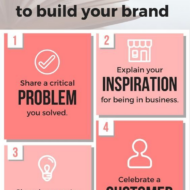Posted by Managementguru in How To, Marketing, Social Media, Strategy
on Mar 14th, 2019 | 0 comments

How To Measure Instagram Marketing ROI & Establish If It’s Worth Your Money Instagram can be a highly effective addition to your business. As a marketing tool, it’s great for driving engagement, increasing sales, boosting brand recognition, and much more. But looking beyond all the fuss, how do you know if it’s actually worth it for your business? Read on to discover how you can measure your Instagram marketing ROI and determine if it’s worth your money in 2019. Recommended readings: Which Digital Channels Deliver the Best ROI? “In this Shopify stores study Artem (from Linkshero) compares 100 Top-tier Shopify stores with 50 SME-type Shopify stores and puts them against 7 factors such as average load speed, list building efforts, average number of dofollow referring domains and more. Check it out!” Shopify Stores: Top-100 vs SMEs (LinksHero Study) What is ROI on Instagram? It has historically been difficult to measure the ROI of social media in general, and Instagram is no exception. However, it is possible to get a good idea of how successful your Instagram marketing actually is by comparing the initial costs against your SMART objectives. The initial costs of Instagram marketing are relatively simple, in their most basic terms: Time: the working hours needed to administer your Instagram strategy. Cost-per-click: this will vary depending on how much you want to pay to get your sponsored posts ad seen (and even if you want to go for a paid ad campaign). While the costs of an Instagram marketing campaign are fairly easy to track, monitoring the outcomes are a little less straightforward. With most social platforms, results are viewed in terms of likes, shares, and comments — rarely as actual sales. And while Instagram’s Shoppable posts make it easy for you to track, it’s less easy to monitor sales from outside the platform but informed by your Instagram marketing. However, using SMART goals can help you evaluate your Instagram ROI with a firm footing. These goals are: Specific: what is your goal? do you want more mentions? Followers? Increased sales? It’s down to you, but be specific about the end result you want to achieve. Measurable: how will you measure your goal? Think about the metrics you will use to identify this. Achievable: what do you need to achieve your goal? What resources, tools, and skills are required? Relevant: is your goal aligned with the overall goals of your business? It should be relevant to your brand. Time: how long will your Instagram marketing campaign take? Set a clear deadline so you know when you should begin measuring your success. Setting SMART objectives as outlined above gives you a strong idea of how successful your Instagram marketing actually is overall. SMART objectives Let’s break down your SMART objectives in terms of Instagram and establish how you can measure your Instagram marketing ROI. Specific Before you do anything else, you should establish exactly what goal it is you want to achieve. Without this, you won’t know the steps you need to take to achieve it. The goals you might be working towards include: Followers Mentions Sales Email subscriptions Of course, these are just a few potential goals you might choose to work towards. There is no right or wrong goal — just choose the one that best serves your business needs. Measurable Once you’ve established your goal, how will you measure this? This is largely tied to your specific goal, and it might be easier for some goals than others. For example, if you want to get more followers, there’s really only one way to measure that. If your follower count increases, then you’ve nailed it. But...

Posted by Managementguru in Business Management, Marketing, Sales, Social Media, Strategy
on Mar 14th, 2019 | 0 comments

What Small Businesses Need to Know About Developing a Brand? If I asked you the name of your business, you could probably respond without a second thought. But what if I were to ask you about your brand? What is the story you would tell, the mission you want to achieve, and the unique characteristics that set your business apart from your competitors? You’d probably need a bit more time, but it would be time well spent. Branding is a powerful tool. It can turn first-time customers into loyal followers and long-time customers into word-of-mouth marketers. Branding, when done masterfully, is the reason we apply “Chapstick” to soothe dry lips, eat “Popsicles” to cool down on a hot day, and “Google” the answer to life’s most pressing questions. Needless to say, brand identity is an important component to your business. Picture Courtesy : 4 Compelling Brand Stories You Should Be Telling How Can You Grow Your Brand? Its clear brand development is important, but how do you build it into your marketing efforts? There are numerous answers to that question, but the following often represent the most common and impactful way to increase brand awareness: Content Marketing: In many circles, content is considered the leading way to do everything from improving organic search results to, as you guessed it, increase brand awareness. Through this method, well-curated articles, blog posts, videos, white papers, etc. are used to increase brand credibility. Content is then distributed through various channels, including email, social media, and on the brand’s website or blog. Picture Courtesy: 18 Types of Content Marketing You Can Use To Grow Your Business Ultimately content works to show your brand as a source of knowledge, whether it pertains to industry trends or customer needs. Social Media Advertising: Social media allows business owners to leverage posts, shares, stories, and comments to engage directly with existing and potential customers. While much of that interaction is free, there are additional paid advertising options that can help small business owners take advantage of social media advertising to increase reach. Picture Courtesy: Best Social Media Management Tools – No More Social Media Babysitting Many social media platforms, including LinkedIn, Facebook, Twitter, Instagram, and Snapchat offer paid advertising opportunities that base ad placement on user data. This can place your brand in front of a specific audience base or target user. Charitable Initiatives: Companies like PetSmart, TOMs, and REI have long attracted customers through their dedication to philanthropic initiatives. By doing so, they’ve associated their brands with a specific mission – helping pets, clothing children, or saving the environment. When “giving” initiatives are leveraged correctly, they highlight your brand’s mission and show your commitment to goodwill. As such, your brand gains notoriety among audiences that share similar interests or philanthropic goals. Picture Courtesy: Top 10 Best Free SEO Tools To instantly Improve Your Google Ranking in 2019 Search Engine Marketing (SEM): Today, SEM refers to any type of paid search efforts and has become an umbrella term used to refer to pay-per-click (PPC) and cost-per-click (CPC) marketing strategies. Through this method, you purchase ad space on search engine result pages (SERPS) on Google, Bing, etc. Instead of ranking organically for specific keywords, SEM allows your brand to show up at the top of a SERP, presenting your brand to highly targeted audiences. You Know How to Grow It, But How Do You Pay for It? While each of these methods can help you increase brand awareness, they often come at a price. Social media and SEM ads are often paid promotions that are based on the number of clicks. Content...




